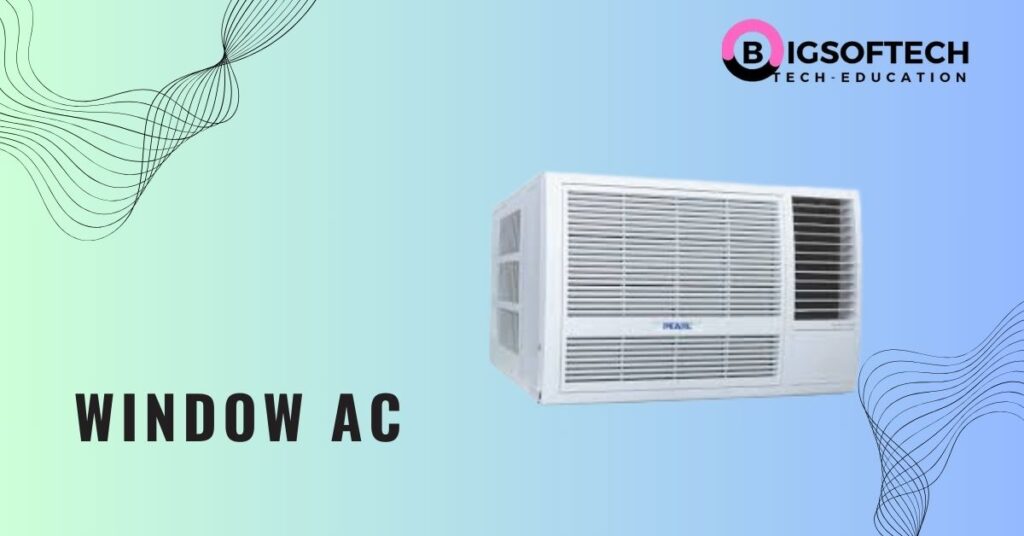If you want to know what is window air conditioner and how does it works, you’re in the right place. This simple guide explains everything in easy words. Whether you’re a student, a technician, or a homeowner, this will help you understand how this small and useful AC keeps your room cool.
In this guide, you’ll learn:
How a window air conditioner works
Its key parts and cooling process
Where it’s best used
Pros, cons, and energy efficiency tips
By the end of this article, you’ll not only understand what is window air conditioner, but also be able to evaluate if it’s the right cooling system for your needs or projects
What is Window Air Conditioner?

A window air conditioner is a self-contained cooling system designed to cool a single room or small area. Unlike central air conditioning, which cools an entire home, window AC units are installed directly into a window or wall slot and work independently. They’re popular because they’re affordable, easy to install, and ideal for small spaces like bedrooms, dorm rooms, or offices.
How does window ac works – Window AC diagram.
A window air conditioner (AC) operates on the principles of refrigeration to cool and dehumidify the air in a room. Here’s a basic overview of how a window AC works:
- Refrigeration Cycle:
- The heart of a window AC is the refrigeration cycle, which involves the circulation of refrigerant gas through a closed loop.
- The refrigerant undergoes phase changes between gas and liquid to absorb and release heat.
Types of Window Air Conditioners
- Single-Hose Units: These air conditioners have one hose that expels heat and humidity from the room. They are typically less expensive and easier to install but may be less efficient than dual-hose units.
- Dual-Hose Units: These models have two hoses—one for expelling hot air and another for drawing in fresh air from outside. This design can be more efficient as it prevents the unit from working as hard to cool the room.
- Smart Window Air Conditioners: Equipped with Wi-Fi connectivity, these units can be controlled remotely via smartphone apps, providing convenience and the ability to adjust settings from anywhere.
Components of a Window Air Conditioner
- Compressor: The compressor is responsible for pressurizing the refrigerant gas. This compression increases the temperature of the gas.
- Condenser Coil: The hot, pressurized refrigerant then flows to the condenser coil located on the outside part of the AC unit. Here, the refrigerant releases heat to the external environment and condenses into a high-pressure liquid.
- Evaporator Coil: The low-pressure, cool refrigerant now enters the evaporator coil inside the AC unit installed in the room. Warm air from the room is drawn over the evaporator coil by a fan.
- Capillary Tube: The high-pressure liquid then passes through an expansion valve, which reduces its pressure. This causes the refrigerant to evaporate, absorbing heat in the process.
- Fan: The AC unit’s fan circulates the cooled and dehumidified air back into the room
How to install a window air conditioner
Installing a window air conditioner is a relatively straightforward process that can be done with basic tools and some careful planning. Here is a step-by-step guide to help you install your window air conditioner safely and efficiently.
Safety Tips During Installation
- Always have a second person assist you when lifting and installing the air conditioner to avoid injury.
- Ensure the unit is properly secured and level to prevent it from falling out of the window.
- Follow all manufacturer instructions and safety guidelines provided with the air conditioner.
Tools and Materials Needed
- Window air conditioner unit
- Support bracket (if required by the unit)
- Measuring tape
- Screwdriver
- Level
- Foam insulation strips
- Screws and mounting hardware (usually included with the unit)
- Drill (optional, depending on your window frame)
Step-by-Step Installation Guide
- Measure the Window Opening
- Measure the dimensions of your window opening to ensure your air conditioner unit will fit. Compare these measurements with the unit’s specifications.
- Prepare the Window
- Open the window and clean the windowsill and frame to ensure a secure fit.
- Install the support bracket (if required). This bracket provides additional stability and support for the air conditioner unit. Follow the manufacturer’s instructions for proper installation.
- Install the Air Conditioner Unit
- With assistance, carefully lift the air conditioner and place it on the windowsill. Slide the unit back until the bottom rail rests securely on the windowsill.
- Lower the window sash until it fits snugly behind the top rail of the air conditioner. This will help secure the unit in place.
- Secure the Unit
- Extend the side panels to fill the gaps on either side of the air conditioner. Use screws or mounting hardware to secure the panels to the window frame. Make sure the unit is level using a level tool.
- If the unit comes with an additional sash lock or bracket, install it to further secure the window and air conditioner in place.
- Seal the Gaps
- Use foam insulation strips to seal any gaps between the air conditioner and the window frame. This helps prevent warm air, insects, and outdoor elements from entering the room.
- Apply weather-stripping around the window sash to improve insulation and energy efficiency.
- Test the Unit
- Turn on the air conditioner and test its functionality. Adjust the settings and make sure the unit is operating correctly. Check for any drafts or gaps that may need additional sealing.
Window Air Conditioner Maintenance Tips
Proper maintenance of your window air conditioner is essential for ensuring its efficiency, longevity, and performance. Here are some tips to help you keep your window AC unit in top condition:
Regular Cleaning Routine
- Clean the Filter:
- Remove and clean the filter every two weeks during peak usage months. Wash it with warm, soapy water, rinse thoroughly, and let it dry completely before reinstalling. If the filter is damaged or excessively dirty, replace it.
- Clean the Coils:
- Dust and dirt can accumulate on the evaporator and condenser coils, reducing efficiency. Clean the coils at the start and end of the cooling season. Use a soft brush or vacuum with a brush attachment to remove debris gently.
- Clean the Exterior:
- Wipe down the exterior of the unit with a damp cloth to remove dust and grime. Ensure the area around the air conditioner is free from obstructions and debris that could block airflow.
Check and Seal Gaps
- Inspect Seals:
- Periodically check the seals around the air conditioner to ensure they are tight and free from leaks. Gaps can allow warm air, dust, and pests to enter your home, reducing efficiency.
- Replace Weatherstripping:
- If the weatherstripping around the unit is worn or damaged, replace it to maintain a good seal. This helps keep the cool air inside and hot air outside.
Drainage System Maintenance
- Check the Drain Hole:
- Ensure the drain hole is clear of debris to prevent water from pooling inside the unit. Standing water can cause mold growth and damage to the air conditioner.
Inspect Electrical Components
- Check the Power Cord:
- Inspect the power cord for any signs of wear or damage. If you notice frayed wires or other issues, replace the cord immediately to avoid electrical hazards.
- Ensure Proper Voltage:
- Make sure the air conditioner is plugged into a properly grounded outlet with the correct voltage. Avoid using extension cords or power strips, as they may not be able to handle the unit’s power load.
Common Problems and Troubleshooting for Window Air Conditioners
Even with regular maintenance, window air conditioners can sometimes encounter issues. Here are some common problems and troubleshooting tips to help you identify and resolve them:
AC Not Cooling Properly
- Clogged Filter:
- Solution: Check and clean the air filter. A clogged filter restricts airflow and reduces cooling efficiency.
- Dirty Coils:
- Solution: Clean the evaporator and condenser coils. Dust and dirt can accumulate on the coils, preventing effective heat exchange.
- Incorrect Size:
- Solution: Ensure your air conditioner is appropriately sized for the room. An undersized unit will struggle to cool the space, while an oversized unit will cycle on and off too frequently, reducing efficiency.
- Low Refrigerant:
- Solution: If cleaning the filter and coils doesn’t solve the problem, the unit might be low on refrigerant. This requires professional servicing to check and refill the refrigerant.
Unit Not Turning On
- Power Issues:
- Solution: Ensure the unit is plugged into a functioning electrical outlet. Check the circuit breaker and reset it if necessary.
- Faulty Power Cord:
- Solution: Inspect the power cord for damage. If the cord is damaged, replace it immediately.
- Thermostat Settings:
- Solution: Ensure the thermostat is set to a temperature lower than the current room temperature. Try resetting the thermostat settings.
- Internal Fuse or Circuit Board:
- Solution: If the unit still doesn’t turn on, there may be an issue with the internal fuse or circuit board. This requires professional repair.
Unusual Noises
- Loose Parts:
- Solution: Check for any loose screws, panels, or mounting hardware. Tighten any loose components.
- Debris in Fan:
- Solution: Inspect the fan for debris. Clean out any obstructions that might be causing the noise.
Water Leaks
- Blocked Drainage:
- Solution: Ensure the drain hole is clear of debris. Clean the drip tray and check that the unit is properly tilted to allow water to drain outside.
- Improper Installation:
- Solution: Check that the air conditioner is installed correctly with a slight tilt towards the outside. This helps water drain properly.
- Ice Formation:
- Solution: If you see ice forming on the coils, the unit may be low on refrigerant or the airflow may be restricted. Clean the filter and coils, and if the problem persists, contact a professional.
Air Conditioner Cycles On and Off Frequently
- Thermostat Placement:
- Solution: Ensure the thermostat sensor is not in direct sunlight or near heat sources. This can cause the unit to cycle on and off more frequently.
- Oversized Unit:
- Solution: An oversized unit may cool the room too quickly, leading to frequent cycling. Consider replacing it with a properly sized unit for better efficiency.
Advantages of Window AC
- Affordability:
- Window AC units are generally more affordable than central air conditioning systems, making them a cost-effective cooling solution, especially for those on a budget.
- Ease of Installation:
- Installing a window AC is relatively simple, and it doesn’t require extensive modifications to the existing structure. It can be mounted in a window or a specially designed opening in a wall.
- Energy Efficiency:
- Compared to some portable air conditioners, window AC units can be more energy-efficient. They have a dedicated location for expelling heat to the outside, which can contribute to better cooling efficiency.
- Cooling Specific Areas:
- Window AC units are designed to cool specific rooms or areas, allowing users to target cooling where it’s needed most. This can be more energy-efficient than cooling an entire home with a central AC system.
- Cooling Power:
- Window AC units come in various cooling capacities measured in BTUs (British Thermal Units) per hour. Users can choose a unit with the appropriate BTU rating for the size of the room or space they want to cool.
- Space-Saving Design:
- Window ACs are compact and do not take up floor space in the room. They are an ideal solution for smaller living spaces or rooms where floor space is limited.
- Customizable Settings:
- Most window AC units come with adjustable settings, including temperature controls, fan speed, and mode options. Users have the flexibility to customize the cooling experience based on their preferences.
- Availability:
- Various brands and models offer consumers a wide availability of window AC units. This range of options empowers consumers to select units that align with their specific cooling needs and preferences.
How to Choose the Right Window Air Conditioner
Selecting the right window air conditioner for your home involves considering several factors to ensure you get a unit that meets your cooling needs efficiently and effectively. Here are the key factors to consider when choosing a window air conditioner:
Room Size and Cooling Capacity
- Measure the Room: Determine the size of the room you want to cool in square feet (length x width).
- BTU Rating: Choose a unit with the appropriate BTU (British Thermal Unit) rating for the room size:
- 100 to 200 sq. ft.: 5,000-6,000 BTUs
- 200 to 300 sq. ft.: 7,000-8,000 BTUs
- 300 to 400 sq. ft.: 9,000-10,000 BTUs
- 400 to 450 sq. ft.: 10,000-12,000 BTUs
- Consider Room Factors: For rooms with high ceilings, large windows, or significant sunlight exposure, you may need a unit with a higher BTU rating.
Energy Efficiency
- Energy Star Rating: Look for air conditioners with an Energy Star rating, which indicates the unit meets energy efficiency guidelines set by the U.S. Environmental Protection Agency (EPA).
- EER (Energy Efficiency Ratio): Higher EER ratings indicate better energy efficiency. Aim for a unit with an EER of 10 or higher.
Noise Level
- Decibel Ratings: Check the decibel (dB) rating of the unit. Lower dB ratings mean quieter operation. Units typically range from 50-60 dB.
- Quiet Mode: Some models come with a “quiet mode” or similar feature to reduce noise levels during operation.
Best Window Air Conditioners for Small Rooms
When choosing a window air conditioner for a small room, consider factors such as cooling capacity, energy efficiency, noise level, and additional features like remote control and smart functionality. Here are some top recommendations for the best window air conditioners for small rooms in 2024:
Voltas 1.5 Ton 5 Star, Inverter Window AC
- Customer Reviews: 3.9 out of 5 stars (774 Rating)
- Cooling Capacity: 1.5 ton
- Room Size: 150 sq ft.
- Special Features: dust filter
- Noise Level: Quiet operation
- Energy Rating: 5 Star
- Included Components: 1 AC unit, 1 Remote Control, 1 User manual, 1 Warranty Card
Features:
- Three cooling and fan speeds
- 24-hour on/off timer
- Remote control
- Easy installation with included installation kit
Pros:
- Energy-efficient
- Easy to install and operate
- Quiet operation
Cons:
- Basic functionality without smart features
Carrier 1.5 Ton 5 Star Inverter Window Air Conditioner
- Customer Reviews: 3.9 out of 5 stars (438 Rating)
- Cooling Capacity: 1.5 ton
- Room Size: 150 sq ft.
- Special Features: dust filter
- Noise Level: Quiet operation
- Energy Rating: 5 Star
- Included Components: Included in the box: Main Window unit, Remote Control, User manual
Features:
- Adjustable thermostat
- Multi-speed fan
- Programmable 24-hour timer
- Clean air ionizer for improved air quality
- Remote control
Pros:
- Effective cooling
- Energy-efficient
- Air ionizer for cleaner air
Cons:
- Slightly heavier than some other models
Blue Star 1.5 Ton 5 Star Inverter Window Air Conditioner
- Customer Reviews: 4.2 out of 5 stars
- Cooling Capacity: 1.5 ton
- Room Size: 150 sq ft.
- Special Features: Dust Filter, Anti-bacterial Filter
- Noise Level: Quiet operation
- Energy Rating: 5 Star
- Included Components: Included in the box: Main Window unit, Remote Control, User manual
Features:
- Mechanical controls with seven temperature settings
- Two cooling and two fan speeds
- Compact design
- Easy installation
Pros:
- Affordable price
- Simple operation
- Compact and lightweight
Cons:
- Remote control or digital display
Lloyd 1.5 Ton 5 Star Inverter Window Air Conditioner
- Customer Reviews: 3.4 out of 5 stars
- Cooling Capacity: 1.5 ton
- Room Size: 150 sq ft.
- Special Features: Dust Filter, Anti-bacterial Filter
- Noise Level: Quiet operation
- Energy Rating: 5 Star
- Included Components: AC Unit, Remote & Batteries, User Manual
Features:
- Digital thermostat with remote control
- Three cooling and fan speeds
- Sleep and eco modes
- 24-hour timer
- Easy-to-use installation kit
Pros:
- Digital controls with remote
- Energy-efficient
- Quiet operation
Cons:
- Slightly more expensive than basic models
Panasonic 1.5 Ton 5 Star Inverter Window Air Conditioner
- Customer Reviews: 3.4 out of 5 stars
- Cooling Capacity: 1.5 ton
- Room Size: 150 sq ft.
- Special Features: Dust Filter, Anti-bacterial Filter
- Noise Level: Quiet operation
- Energy Rating: 5 Star
- Included Components: AC Unit, Remote & Batteries, User Manual
Features:
- Wi-Fi enabled with smart features
- Control via smartphone or voice commands (compatible with Amazon Alexa and Google Assistant)
- Energy saver mode
- Digital controls with remote
- Easy installation kit
Pros:
- Smart functionality
- High cooling capacity for larger small rooms
- Energy-efficient
Cons:
- Higher price point due to smart features




